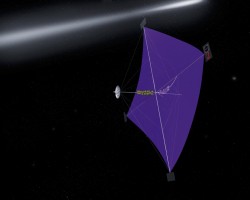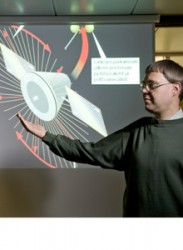Solar sails were once thought to belong in the realms of science fiction. Huge canopies of lightweight tin foil catching the solar photon breeze, slowly allowing spacecraft to cruise around our solar system propelled by the small but continuous radiation pressure. Recent years however have shown that solar sail spacecraft could be engineered in reality, and a new solar sail invention from the Finnish Meteorological Institute could push this goal one step closer. Rather than using solar radiation pressure, this new concept makes use of the highly charged particles in the solar wind to give the craft its propulsion. Additionally, through radio wave electron excitation, the system may amplify the solar wind acceleration effects, giving the spacecraft a “boost” function…

Traditionally, solar sails make use for the momentum carried by photons of electromagnetic radiation from the Sun. Using a huge canopy of ultra-lightweight (but robust) material, the sail experiences a force from the incident sunlight. Some advanced concepts also theorized the use of planetary lasers to propel solar sail-powered spacecraft from A to B. Opting for solar propulsion would be the ultimate energy conservation method yet, optimizing payload transportation, maximizing fuel efficiency. Make a solar sail big enough, steady momentum can be transferred from the solar photons, accelerating the spacecraft. There are of course many hurdles to this design, but prototypes have been built (although many failed to make it into space due to rocket launch failures).
In a departure from the photon-powered solar sail, scientists and engineers have started to look into the properties of solar wind particles as a possible source of propulsion. The advantages of using solar wind particles are they a) are electrically charged, b) have high velocity (interplanetary scintillation observations have deduced velocities as high as 800 km/s, or 1.8 million miles per hour), and c) are abundant in interplanetary space throughout the solar system (particularly at solar maximum). So the new Finnish concept will take full advantage of this highly charged interplanetary medium. Using a fan of very long, electrically charged cables (stretching many kilometres from the central spacecraft), the similarly charged solar wind particles (mainly positively-charged protons) will hit the fan of positively-charged cables (generating a repulsive electric field), giving the cables a small proton-sized “kick”, exchanging their momentum into spacecraft thrust. Cable charge is maintained by a solar-powered electron gun, using two conventional solar panels as an energy source. A radio-frequency “boost” will also be tested in the prototype model. Radio waves will cause electron heating, possibly enhancing the solar sail’s thrust.
The project is currently being engineered and researchers from Finland, Germany, Sweden, Russia, and Italy are currently developing various components of the solar sail. Successful implementation of the prototype that could be launched in three years depends on securing $8 million (5 million euros) in funding.
Sources: Finnish Meteorological Institute, Live Science



Actually, most solar sail projects have not used “tin foil.” They use extremely thin plastic film — usually polyester (Mylar) — that has been aluminized. It’s a very thin version of the same film used to make those shiny, helium filled birthday or Valentine balloons you get at the local supermarket.
Conventional sails would give us six times the speed of a rocket. It will be interesting to see how much faster these new sails can go if the calculations are correct. It may help us to build the dream of solar cells on the Moon, helping to drive down pollution. By getting to asteroids cheaper, we do not have to do as much mining on the Earth. This would also cut down on pollution. It would also improve the economy here on the Earth.
We would be able to go other places such as Mercury, Mars, Venus and Ceres. It would be a boom to mankind.
This technology does not seem practical for trips over short distances or for short durations… probably not manned flights at all. It would be even slower than Ion systems.
To be fair to rockets… when you say that sails would be 6 times faster than rockets… do not forget fusion rockets. They could hit better than .1C. If the solar particles are only going at less than .01C… That would mean rockets still have the potential to be much faster.
It doesn’t look like there’d be much room in the “tin can” below the solar panels in the graphic shown. No place to stretch your legs on a trip to Mars or Ceres! It would be interesting to see how large of a capsule could be driven by the momentum generated by the proton repulsion on practically sized cables (i.e. how many kilometres of cables would be needed for a ship of practical size for a Moon or Mars trip?).
dont you need somone to help sail it?
Interesting concept. Any idea how the charged particle sail compares with the photon sail in terms of acceleration and whatnot? Protons at that speed should impart a higher momentum per particle as compared with most photons streaming from the sun, but I should also think there would be far less of them to provide their kick…
Hi Astrofiend
The proton density is ~ 5E+6 per m^3, speed roughly ~ 400 km/s (800-900 km/s is unusually high) and so the ram pressure is ~ 1.34E-9 Pa. The light flux incident on a reflector at 1 AU is 1368 W/sq.m on average. The pressure is 2E/c = 9.13E-6 Pa for perfect reflection. Thus the light pressure is much higher than the ram pressure.
The advantage of the “wire sail” is that the wires can, in principle, mass a lot less than a sail. Can’t do it with photons, but you can with the solar wind. Also the proposed design seems to have a pretty easy deployment system compared with the difficulties of photon sails.
Solar sails, in principle, can get much higher final velocities than solar wind sails – over 0.01c – but for near term missions the solar wind seems the easier option.
I like it and I think they’ll make it work.
Just think, even if it is not practical for human space travel, we’ll be able to put Cassini-type orbiters around EVERY planet, dwarf planet and major asteroid in the Solar System.
We’ll NEVER get away from the computer!
Hmm… I’ll believe it when I see it. Doesn’t seem to be practical. At least in this half of the century. And let’s hope that before we get to the latter half, we will have come up with better and more practical propulsion systems.
Cheers Adam. As I said, interesting concept!
Perhaps instead of dreaming of unrealistic ideas of deploying arrays kilometers wide, maybe we should encourage our engineers to perfect solar cells. Yes I said “cellsâ€, not “sailsâ€. Cells that are near 100% efficient and a storage device that can dissipate that collected energy to a tolerable engine at increasing rates. Cells that are capable of collecting photons (or possibly even electrons from solar or cosmic rays).
We’re not going to do anything appreciable until we get travel time worked out.
Solar sails? C’mon….
Why not? By altering the charge of certain cables, you could steer it. Also, couldn’t it also be used to collect energy whenever it isn’t being used as propulsion?
We do still need quicker short distance transportation, but say, long term, you use solar sails to get up to speed on an earth/moon transit vehicle, making use of solar sails and gravity assists. Or an Earth/Mars transit vehicle?
But we will still need rocketry.